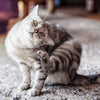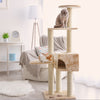Can Cat Litter Be Composted?
- by Rufus and Coco
Cat litter can be manufactured using a variety of materials, some of which are more or less safe for our feline friends. But the way you dispose of cat litter can have an impact on the environment, in either a positive or negative way.
Can cat litter be composed? We’re answering this question and many more in today’s article, so keep on reading!
Can cat litter be composed?
Unfortunately, a short and clear answer to this question does not exist. It’s correct to say that it all depends on the type of litter you have chosen for your cat.
For example, litters made of biodegradable materials are compostable, but not all of them are the same in this sense.
Cat litter manufactured from less sustainable materials, such as that which contains sodium bentonite, might be compostable, but it is extremely detrimental to the environment due to the way it is produced.
The best materials for compostable litter are corn, recycled paper, wheat, and pretty much anything that is made from plants (including tofu varieties).
These are the easiest to break down and can be considered similar to the dry leaves that you’d add when making your own compost, for instance.
Our Wee Kitty Clumping Corn Litter is a great option since it’s extra-absorbent, flushable, and of course, biodegradable. It doesn’t contain any chemicals that might hurt your cat or affect your compost either.
The Wee Kitty Eco Plant Clumping Litter is another excellent choice, but the difference between this one and the corn variety we’ve previously mentioned is that it’s made from soy fibres and wheat. As such, it’s also compostable and biodegradable, and it quickly makes scoopable clumps.
What to know before composting your cat litter
The truth is that cat waste contains a variety of microorganisms, and they range from parasites to bacteria that can be transmitted to humans. The best-known disease that people can get from cat feces is a parasite called Toxoplasma gondii, which can be harmful, particularly to pregnant women and infants.
So even before you begin composting your feline buddy’s litter, you should always handle it with care, especially if you haven’t dewormed your cat on a regular basis. Also, not all dewormers kill Toxoplasma species, but that’s a whole different story.
One way of properly getting rid of your cat’s waste is using a quality scoop such as our Coco Hook-On Litter Scoop. It hooks securely onto the side of your litter tray for easier litter clean up.
Besides, being as hygienic as possible with the litter, you also have to consider that you cannot use the resulting compost for growing vegetables that you then eat. Cat urine and feces can carry bacteria such as Escherichia coli (or worse).
You can use the compost for decorative plants or for decorative trees.
How to make compost using cat litter
Although cat waste is pretty rich in nitrogen, you have to add even more in order to actually make your compost.
Some of the other things that you can add to your compost bucket are plant materials such as grass clippings, your food scraps (avoid using chicken bones and other animal remnants just to be on the safe side of things), animal manure (horse, cow, and chicken manure are excellent), and a very small amount of soil.
Most people make their compost using greens and browns, meaning fresh vegetables (and green leaves) and food scraps and dried leaves, paper, cardboard, or straw.
It takes a while for the compost to mature, and you also have to check on it every once in a while. If you want to use it in your garden (not for your food), you have to turn it over and over at least once a week.
Telling whether your compost is healthy or not is easy. A good one will be moist, and you’ll perhaps see steam coming out of it (a clear sign that the bacteria is doing the job). A bad one will be dry, so you’ll need to add more nitrogen, so more cat litter and more food scraps.
What types of cat litter should be avoided for composting?
Any kind of crystals, especially litters that contain chemicals, including sodium bicarbonate (for its deodorising properties), deodorant, or perfume, should not be used for composting.
Clay litter is also a bad idea as it doesn’t create any reaction with the rest of the compost ingredients. In fact, it might even inhibit bacterial growth or just make for a lengthier process.
You want things to be as natural as possible when it comes to composting. Otherwise, the bacteria is not going to survive, and the pile will remain dry and never become the rich compost you want to add to your plants.
Conclusion
Some types of cat litter can be composted, but you should never add the resulting compost to the vegetables that you grow in your garden. Instead, cat litter compost can be used (with great results) for any decorative plants you might have around the house.
The safest and best compostable cat litters are made of natural materials such as wheat, soy, or any other type of grain such as corn. Tofu varieties are also acceptable.
Avoid getting heavily scented litter because it affects your cat’s sense of smell, and also because it’s not going to help with the composting process in any way.
Last but not least, try to pay attention when handling your cat’s litter, even if you use a scoop and flush out the waste. Feces can carry potentially dangerous germs and parasites that can be transmitted to people.
- Posted in:
- cat
- cat litter
- cats
- clean-up
- how to help
- tips
- weekitty








